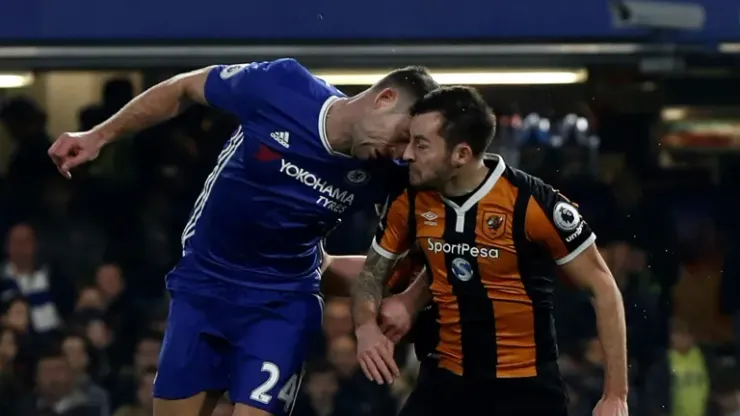London (AFP) – Ryan Mason’s clash of heads with Chelsea’s Gary Cahill has again set alarm bells ringing over the risk of head injuries across a number of high profile sports.
The 25-year-old Hull City midfielder remained “stable condition” in hospital after the brutal impact with Cahill, 14 minutes into Sunday’s Premier League match at Stamford Bridge, left him with a fractured skull.
Defender Cahill got back to his feet and headed the Premier League leaders second goal in their 2-0 win. But Mason, after eight minutes of treatment on the pitch, was carried off on a stretcher while receiving oxygen before being taken to a London hospital.
He underwent surgery and Hull said Mason had spoken with visitors.
A leading critic of the way football deals with head injuries said Mason’s treatment had been “exemplary”.
Peter McCabe, the chief executive of brain injury charity Headway, was with other spectators who saw the Stamford Bridge collision.
“I was actually at the match and, while it was upsetting to witness the incident, it was encouraging to see the exemplary reaction of the medical teams,” said McCabe.
“Headway has been critical of the way in which head injuries have been treated in many high-profile football incidents in recent years, but it is positive to see that lessons appear to have been learned.”
Chelsea manager Antonio Conte revealed Cahill’s half-time condition “wasn’t really good”.
The England centre-back had, however, received injury assessment during the break in play when Mason was treated.
Headway’s preferred stance is that if there is any doubt, an injured player should be withdrawn from the match.
– Rugby worries –
This is the policy in rugby union but several recent high-profile cases, where the likes of Samoa’s TJ Ioane and Wales’s George North have played on while seemingly still concussed, have led to questions over whether the rules are being applied correctly.
Rugby chiefs recently announced changes on what constitutes a fair tackle in a bid to reduce concussion injuries.
A report released this month by England’s Rugby Football Union revealed the number of concussions suffered in English rugby had risen to a record high.
The RFU’s annual injury audit for 2015/16 revealed that concussion now accounts for a quarter of all injuries -– up from 17 percent the year before.
Concussion has become a major issue in many sports, amid concern over the impact on players and the risk of potentially huge compensation payments.
Children under 10 are not allowed to head the ball in official leagues in US soccer.
In December, the US Supreme Court upheld the National Football League’s $1 billion concussion settlement which covers more than 20,000 retired American football players based on brain injuries linked to concussions during their careers.
While the dangers of concussion in boxing, where the clearest path to victory is a knock-out, have long been obvious, it appears basic tasks in other sports could also pose the risk of head injury.
Last year researchers at Scotland’s Stirling University published a report saying heading a football can significantly affect a player’s brain function and memory.
After former England striker Jeff Astle, renowned for his heading ability, died aged 59 in 2002, an inquest ruled he had suffered death by “industrial injury”.
Meanwhile the death of Australia’s Philip Hughes in November 2014 led to calls for cricket to ban the ‘bouncer’, a delivery aimed at the upper body and head.
The 25-year-old Australia batsman died from bleeding on the brain as a result of being hit on the neck by a rising ball from Sean Abbott while batting in a domestic match at the Sydney Cricket Ground, despite wearing a protective helmet.
200+ Channels With Sports & News
- Starting price: $33/mo. for fubo Latino Package
- Watch Premier League, Women’s World Cup, Euro 2024 & Gold Cup
The New Home of MLS
- Price: $14.99/mo. for MLS Season Pass
- Watch every MLS game including playoffs & Leagues Cup
Many Sports & ESPN Originals
- Price: $10.99/mo. (or get ESPN+, Hulu & Disney+ for $14.99/mo.)
- Features Bundesliga, LaLiga, Championship, & FA Cup
2,000+ soccer games per year
- Price: $5.99/mo
- Features Champions League, Serie A, Europa League & Brasileirāo
175 Premier League Games & PL TV
- Starting price: $5.99/mo. for Peacock Premium
- Watch 175 exclusive EPL games per season






